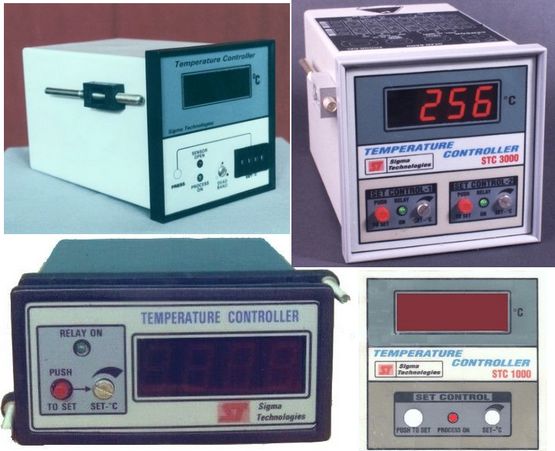Production and Calibration of Controller
Production Checklist of STC1000
An analog temperature controller is not very easy to make. It is used in tough industrial environment and has to perform with reliability and accuracy on continuous operation.- Has Transformer been soldered properly with reinforced pads - Scrape with blade area around pad and make lead bridges to support transformer.Front Card and Rear Card must have very thick solder bridges after fixing sq. post.
- Is the Front and back stickers and SL. No Sticker
properly stuck - In Front Sticker the holes for
switch, pot LED etc. must be without Burrs file and improve.
Acrylic should not have cynoacralate stains. In the back
sticker there should not be any wrinkles use rubber solution
(fevibond) to stick properly.
- Are all the Threaded parts and Plastic parts fixed with fevibond - Use Fevibond (very little) for the CJ box in rear panel all Metal screws and loose mechanical parts in Pots, plastic threads and pillars. This prevents parts from breaking loose during transportation or vibrations, All Nuts / Bolts fix tightly .
- Are all the Pots. Turning freely and is direction proper - Clockwise is always increment or increase in a parameter and anti-clockwise is decrement of any control or parameter. All pots should turn without friction.
- Are all the Front panel components Fixed properly - All Four Displays are required Fourth is for Overrange and Polarity. LED’s are for Load On or Process on and Should be neatly visible above sticker and Switch should not get stuck after cabinet is closed and screwed.
- Only two screws must be visible on the back panel -
Cover Pot clamp screw, card fixing screw etc. by Black
insulation tape.Use Ni. plated Phillips / Universal head
Screws for fixing back plate.
- Are all other items in the final packing - Check by fixing both side clamps and file if required add Instruction manual in Cover or with Invoice and DC.
- Sources of omissions and neglect checked by Visual Inspection - Gnd to Earth Capacitor to be added 0.01uF 103 1kV, Polarity of Electrolytic and diodes , Regulator tab touching any conductor, Loose wire strands, Solder Bridges absent at places where it is required.
- Troubleshooting when a card does not work - Keep always a 3D reference of a working unit / card compare component to component by visual inspection wrong polarity of diodes / Tx / IC, wrong value of Resistor or Low value capacitors missing jumpers solder bridges or hairline shorts at edge of board or pad to pad lead streaks.
12-Bit, 4-20mA Loop-Powered System
Calibration and Testing Procedure for STC1000P Proportional

Power on unit and leave for 15 mts
1-Wire Temperature Control
Calibration Of Room Temperature Preset And Full Scale Trimpot.
Feed 0.00 mV to the TC input using a millivolt source and adjust P1 (PR1) Z for Display to read Room temperature as shown by a mercury thermometer.Feed mV corresponding to maximum temperature and adjust P2 (FS) for Display to read full scale temperature. Verify Room temperature again by feeding 0 mV repeat three iterations till the Zero and Full-scale readings are set to Room temp (RT) and FS temp + RT respectively.
e.g. If room temp. is 26 deg. C and as per tables 0 mV is 0 deg C and 16.39 mV is 400 deg C for K type then feeding 0 mV we should read 26 deg C on TC and feeding 16.39 mV we read 400 + RT i.e. 426 deg C.
| Range | Input mV | Temperature | Reading on TC |
| Zero | 0.00 mV | ||
| 25 % FS | |||
| 50 % FS | |||
| 75 % FS | |||
| Full Scale |
Testing of Proportional Control and Settings.
Adjust Setpoint to Read 300 deg C, Feed mV for unit to read same PV. Set Proportional Band to MIN fully anticlockwise till end (100K Ohms).If Process ON Led in ON turn anticlockwise till it just turns OFF or flickers. If Process ON Led in OFF turn clockwise till it just turns ON or flickers. Now the error cal is calibrated at 300 deg C (for other temperatures it may differ)
Set Proportional Band to MAX fully clockwise till end (000 Zero Ohms). (Now SP must be at 300 and PV must be at 300). Now LED will turn ON for 5 Seconds (approx.) and OFF for 5 seconds for 10 Sec cycle time for shorter cycle times just observe symmetrical flashing.
Decrease mV (PV) till LED turns fully ON no flickering note this Value T1. Increase mV (PV) till LED turns fully OFF no flickering note this Value T2. T1 is lower end of PB and T2 upper end T2 - T1 = PB i. e. the Prop Band .
e.g. T1 = 295 T2 is 305 305 - 295 = 10 hence PB = 10 deg C.
Verification of Relay operation.
| RESISTANCE “NO” TO “C” in Ohms |
|
| GET RELAY TO TURN ON | |
| GET RELAY TO TURN OFF |
Danger ! DMM is in Ohms Mode, Even if one probe touches 230 V DMM is Gone, so take extra care while doing this test probe only relay contacts.
For Pulse Output model for SSR e.g. STC1000KPP Use a DMM 20 V mode to observe 12V DC when Process ON and 0 V when Process off.
Earth and isolation and safety related tests..
Off Unit before this Test| GND TO EARTH RESISTANCE | OHMS |
| TRANSFORMER RESISTANCE L to N | OHMS |
| WINDING TO EARTH RESISTANCE L to E | OHMS |
| CHASSIS TO EARTH RESISTANCE | OHMS |
General Checklist to ensure optimum quality.
- DOES LED TURN ON WHEN RELAY IS ON AND VISE VERSA ............
- DOES DISPLAY READING JUMP WHEN RELAY OPERATES ............
- SCREWS LOCKED WITH ADHESIVE, POTS TURN SMOOTH. ............
- ARE ALL STICKERS STUCK PROPERLY WITHOUT FOLDS ............
- HAVE EXTRA HOLES AND SCREWS COVERED BY B TAPE ............
- HAS THE SENSOR POLARITY BEEN MARKED WITH PAINT ............
- HAS THE DB / PB KNOB MARKED BY A WHITE PAINT LINE. ...........
Operation of displays and Controls.
- Note SP Min ................ SP max ...........
- Note PB Min ................ PB max ...........
- Feed mV for display to read 1234 Counts reading ................
- Feed mV for display to read 345 Counts reading
................
- Feed mV for display to read -456 Counts reading ................
- Feed mV for display to read 1xxx Overrange rdg.
................
- Verify Decimal Point has been connected record in this > 1 9 9 9
- Display should have uniform brightness without modulation.
- Process ON LED must be bright and Visible outside.
- Push-button switch should not get stuck on repeated operation.
- Proportional Temperature controller Calibration
- Proportional Flow controller Calibration
- Calibration Report of 4-20mA Transmitter
- Modification or additions for STC1000
Back to Process Control
Instrumentation
...
...
...
...
...
delabs Technologies
30th Aug 2020
...
The documents, software, tools and links are provided to enhance the ability of an electronics student, hobbyist or professional by sharing information. The information, links etc. should be used by the website visitor, at his or her own risk and responsibility. There may be concept, design and link errors in the pages.
Creative Work, ideas and documents of delabs can be used for Product Design and Development by R&D Engineers, Hobbyists, Students and even firms for creating useful products. These cannot be used for reprint, replication or publishing online or offline.

